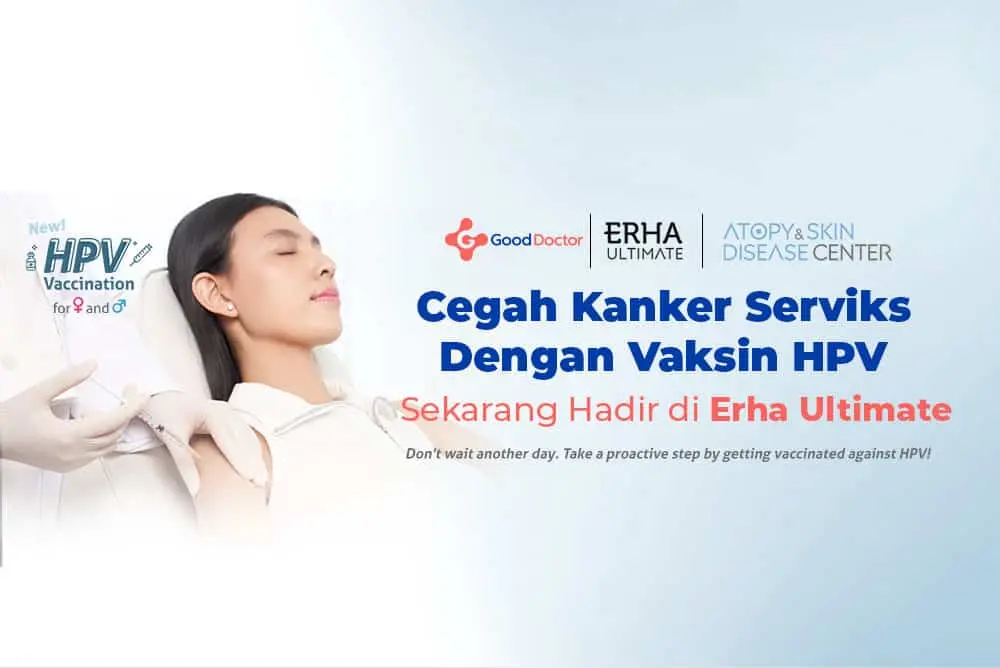Share This Article
If you are sexually active and often feel pain during intercourse, for example, one thing you need to watch out for is human papillomavirus (HPV) infection. Giving the HPV vaccine is one of the efforts to prevent HPV infection.
What are the HPV vaccine options and what are the rules for administering them based on age? Let’s continue reading the article below to get more complete information.
Understanding HPV and How It Is Transmitted

HPV is a virus from the Papillomaviridae family. This virus has a very high level of tissue tissue, how it works by infecting the skin and mucosa. There are at least 200 types of HPV whose characteristics have been identified, including their potential to cause cancer.
As a result, 12 types of HPV were classified as having a high risk of causing cancer in humans. Namely, types 16, 18, 31, 33, 35, 39, 45, 51, 52, 56, 58, and type 59. Where type 16 is the highest risk.
The World Health Organization (WHO) explains that HPV is the most common viral infection that attacks the male and female reproductive tract. In women, HPV infections mostly attack those of reproductive age or childbearing age. WHO classifies women of childbearing age as starting from the age of 14-49 years. It can be concluded that even teenagers who have had their first menstruation have the potential to become infected with HPV. Data shows that around eight out of 10 people (85 percent) can be infected with HPV during their lifetime.
Most HPV infections do not cause symptoms and can heal on their own. However, persistent or permanent infections if not treated can cause a number of diseases, such as cervical cancer, anal cancer and genital warts.
According to the United States Centers for Disease Control and Prevention (CDC), someone who is sexually active is at risk of having an HPV infection if they have sex with a partner who is infected with the virus. HPV is most often transmitted through vaginal or anal sex.
Apart from sexual contact, the virus also spreads through physical contact with infected people. Namely by touching the genital skin or being exposed to the mucous membranes and body fluids of an infected person.
Prevalence of HPV Infection in Men and Women
Based on a global meta-analysis in 2010, an estimated 12 percent of adult women (<25 years) were infected with HPV detected in their cervical specimens. Before vaccination, HPV types 16 and 18 were the types of HPV that most commonly infected women throughout the world.
Meanwhile in men, a multicenter clinical trial on a group of heterosexual men showed that 19 percent of HPV infections were found in the penis, 13 percent in the scrotum, 8 percent in the perianal area and 21 percent in other body areas.
Diseases Caused by HPV Infection
Almost 70-90 percent of cases of HPV infection do not cause symptoms and can heal by themselves within 1-2 years. Meanwhile, if not treated, persistent or permanent HPV can cause diseases including cancer.
In 2018, it is estimated that globally 91 percent of HPV infection cases are related to cervical cancer. Cervical cancer is the fourth leading cause of death in women due to cancer in 2020 with cases estimated to reach 604 thousand and the death toll reaching 340 thousand.
The following are a number of diseases that can be caused by HPV infection:
1. Cervical cancer or cervical cancer
About 5-10 percent of women infected with HPV develop persistent infections. Persistent infection is what develops into cervical cancer. The time between HPV infection and cervical cancer takes at least 15 to 20 years. Unfortunately, the development of infection into cancer is rarely recognized so treatment is often too late.
2. Anal cancer
HPV is the cause of more than 90 percent of cases of anal or anal cancer. In women, cases are almost twice as common as in men.
3. Oropharyngeal cancer or throat cancer
As many as 70 percent of throat cancer cases in the United States are caused by HPV. In this cancer, HPV usually infects the tonsils or the back of the tongue.
4. Other cancers
such as vaginal cancer (78 percent), penile cancer (53 percent), and vulvar cancer (15-48 percent).
5. Genital Warts
(condyloma acuminata), namely lumps that appear around the genital organs, both men and women. Sometimes, these warts are accompanied by itching and pain. This condition is triggered by the growth of new soft tissue that develops from an HPV infection.
The HPV Vaccine is Effective in Preventing HPV Infection
What is the HPV Vaccine?
The Advisory Committee on Immunization Practices (ACIP) at the Centers for Disease Control and Prevention (CDC) recommends administering the HPV vaccine to prevent new HPV infections and prevent HPV infections that have a risk of causing cancer and other diseases.
A vaccine license to prevent disease caused by HPV infection was first granted in 2006. Now at least six HPV vaccines have been licensed. All licensed HPV vaccines use recombinant DNA and cell culture technology from purified L1 structural protein.
The HPV vaccine does not contain live biological products or viral DNA so it is not infectious.
Types of HPV Vaccine
In Indonesia, the types of vaccines that are often used are bivalent and tetravalent or quadrivalent. Bivalents contain two types of HPV viruses, namely types 16 and 18. This type of vaccine prevents cervical cancer. Meanwhile, quadrivalent is a vaccine that contains four HPV viruses, namely types 6, 11, 16 and 18. This vaccine can prevent cervical cancer as well as genital warts.
Then there is also a type of nonavalent vaccine which contains nine types of HPV, including types 6, 11, 16, 18, 31, 33, 45, 52 and 58.
HPV vaccination is not to treat infections or diseases caused by HPV infection. In accordance with its preventive function, the HPV vaccine aims to provide protection to children aged 9-12 years because it is estimated that it can prevent up to 90 percent of cancers related to HPV infection.
When to Give the HPV Vaccine
It is recommended that HPV vaccination be given to children aged 9 years, both girls and boys. Vaccines are given as early as possible because the effectiveness of the vaccine will be better at a younger age than in older children.
Bivalent HPV vaccine
This type of vaccine is for girls and boys aged 9–14 years with a 2 dose schedule (5-13 months apart). If the recipient’s age at the time of the first dose is ≥15 years, three doses should be given (at 0, 1–2.5 months and 5–12 months).
Quadrivalent HPV vaccine
Gardasil4 vaccine for girls and boys aged 9–13 years with a 2 dose schedule (6 months apart). If the recipient’s age at the time of the first dose is ≥14 years, three doses should be given (at 0, 1–2.5 months and 5–12 months).
Nonavalent HPV vaccine
Gardasil9 vaccine for girls and boys aged 9–14 with a 2 dose schedule (5-13 months apart). If the recipient’s age at the time of the first dose is ≥14 years, three doses should be given (at 0, 1–2.5 months and 5–12 months).
Side Effects of HPV Vaccination
Overall, the side effects are mild. The most common side effects include pain, swelling or redness at the injection site.
Then there are also those who feel dizzy, headache, nausea and vomiting and tired after the injection. So it is highly recommended to sit 15 minutes after the injection to prevent the risk of fainting.
HPV Vaccine Options to Prevent HPV Infection
One example of a tetravalent type of HPV vaccine product, namely Gardasil, has been used in the HPV vaccination program by the National Health Service (NHS) in England since 2012. Then in 2021 use was increased to Gardasil 9.
Gardasil 9 has received approval from the United States Food and Drug Administration and can be given to both girls and boys as well as adults.
Gardasil 9 contains nine types of HPV, namely 6, 11, 16, 18, 31, 33, 45, 52 and 58. Of which two types, namely types 16 and 18, are the HPV that causes most cervical cancer in the UK.
Meanwhile, HPV types 6 and 11 are the cause of around 90 percent of genital warts. Using Gardasil 9 can help children, both girls and boys, avoid the risk of cancer and genital warts.
Apart from health service centers such as clinics or hospitals, now you can get the HPV vaccine at the ERHA Atopy & Skin Disease Center (ASDC). Available in single treatment or packages with a choice of Gardasil 4 or Gardasil 9 vaccines. Meanwhile, in package form you can get three injections. The cost offered for HPV vaccination at ERHA ASDC starts from IDR 1,500,000.
This is information about HPV and steps to prevent infection by getting the HPV vaccine. Don’t delay getting the HPV vaccination to prevent infection or disease caused by HPV, come and visit the nearest ERHA ASDC in your area.


